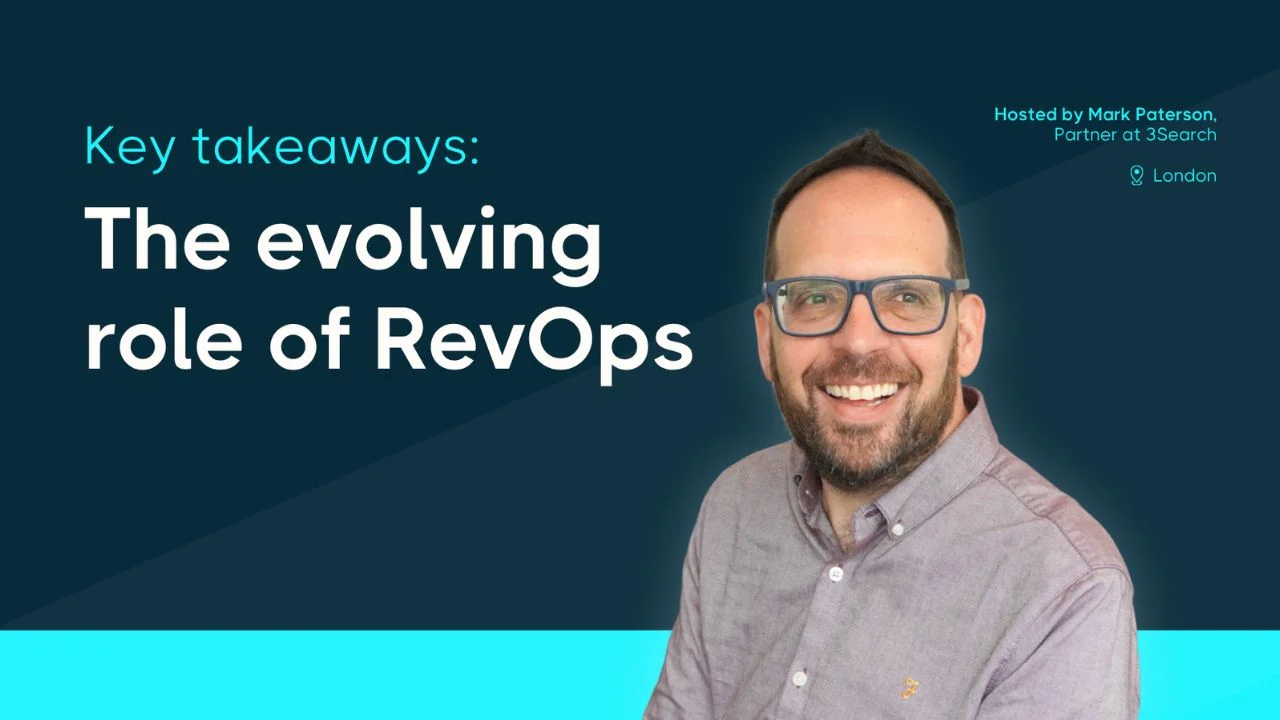The role of the CRO is evolving fast. Today’s leaders are expected not only to deliver growth but also to work the data and unify sales, marketing, and customer success under a single strategy. Revenue Operations (RevOps) has become the framework many are turning to, but what does it really mean in practice for the modern CRO?
At our latest roundtable event, hosted by Mark Paterson, we brought together RevOps Leaders to explore how adopting this mindset can transform performance and prepare organisations for the future. They covered:
- The evolving role of RevOps
- Where should the function sit in a business?
- How is technology impacting revenue operations
Keep reading for the key takeaways from the conversation.
The growing importance of RevOps
Revenue Operations has evolved far beyond its sales ops roots. It’s now the strategic link that unites customer success, marketing and sales teams around a single goal - creating predictable, scalable growth.
Yet, as our attendees agreed, revenue operations still lacks a universal definition. Its responsibilities vary dramatically depending on company size, maturity, and structure. For instance, a RevOps Leader at a start-up may be hands-on with tooling and data, while in an enterprise they would be focused on strategy and board-level reporting.
Despite that elasticity, everyone agreed that RevOps is now central to how modern businesses operate.
The UK vs US approach to RevOps
The group agreed that US companies are generally ahead in adopting revenue operations, treating it as a commercial growth function rather than a support role.
However, UK professionals often demonstrate greater creativity and problem-solving due to smaller teams and leaner budgets.
The rise of fractional and consultancy RevOps
However, investment in RevOps is growing in the UK market. With demand for expertise outpacing supply, many businesses are turning to fractional RevOps models. We’re seeing many organisations bring in interim specialists or consultants to build frameworks, manage tech implementations, or work across PE portfolios.
Used well, this can be a cost-effective bridge for scaling businesses, particularly for project-based needs like CRM migration, CPQ setup, or data unification.
When to hire your first RevOps leader
The consensus was clear among the leaders in the room: invest early.
Most leaders reported that they had inherited tangled systems, inconsistent data, and patchy reporting. All are problems that could have been avoided with an earlier revenue operations hire.
The advice? Start with a builder profile - someone technical and hands-on who can create structure. As the business matures, transition to a strategic operator capable of scaling processes and influencing executive decision-making.
“The first RevOps hire might not be the one who takes you through your next growth phase and that’s okay.”
Where should RevOps sit in the organisational structure?
As the definition of the role varies from business to business, so does the reporting lines. Where the RevOps team sits in an organisation determines the impact they’re able to have on a business.
Reporting lines reveal company mindset
Where RevOps sits in an organisation often determines how it’s valued. At the roundtable, attendees shared that they have seen the function report into both finance and commercial teams with mixed results.
“CFOs are away from risk; CROs are towards opportunity.”
Reporting into the CFO can often limit innovation, given finance’s focus on control and risk. The most effective structures see RevOps either reporting to the CRO or CEO, with a direct voice at the executive table.
The CRO partnership
When working in sync, the CRO and RevOps Leader function as one.
A strong partnership means shared goals, mutual accountability, and constant collaboration. That depth of understanding turns revenue operations into more than a support function and helps it make a real impact on commercial success.
Shifting the perception from cost centre to growth driver
In some organisations, the role of RevOps is still seen as a back-office cost. The best way to change that narrative is to give clear metrics for the team to work towards. Revenue operations teams should take accountability for removing inefficiencies and driving tangible commercial value.
One example shared was the consolidation of more than thirty individual sales data licences into a single offshore team, cutting costs and improving output.
By linking operational improvements directly to business performance, RevOps builds credibility as a value creator, not a cost.
How is technology influencing the evolution RevOps?
Investors don’t want more dashboards, they want insight. Data alone isn’t enough for boards and revenue operations must translate numbers into action and context, explaining not just what’s happening but why.
New technologies are enabling RevOps teams to achieve that.
AI is transforming forecasting
AI tools such as Clari, Gong, and Caliber AI are revolutionising forecasting accuracy, helping leaders predict pipeline outcomes with precision. However, participants agreed that AI’s true power lies in surfacing patterns and not replacing human insight.
One speaker summarised with, “AI shows you the dark matter – the data that falls between systems. But you still need human judgement to interpret it.”
As buyer behaviour becomes more automated and search journeys change, AI will only deepen the need for alignment between RevOps, sales, and marketing teams.
Final thoughts
As one of our attendees concluded, “A business is a mould and RevOps is the jelly that fits into that mould. It sets different in a different shape every single time.”
Whether you’re a start-up hiring your first RevOps Lead or a PE-backed scale-up defining your next phase of growth, building a strong partnership between your CRO and RevOps team is crucial for growth.
Thank you to everyone who joined our roundtable
If you’d like to join us at future events, please visit our events calendar. For support with your RevOps recruitment needs, get in touch with our specialist team.



